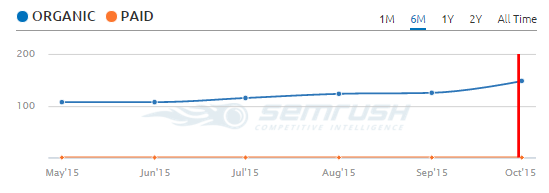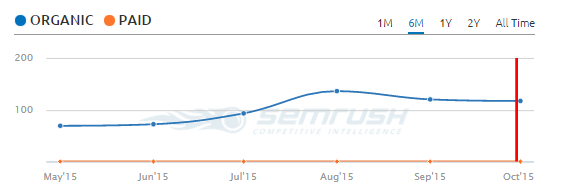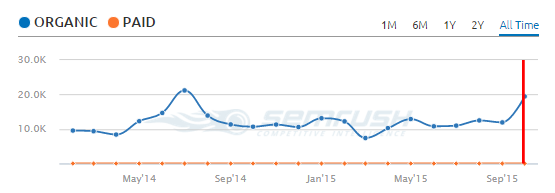by Venchito Tampon Jr | Last Updated on October 24, 2021
The value of every marketing practice lies on its ability to generate results. Same goes to link building.
Engagement, social shares, referral visits and assisted conversions are some key results of an effective link building campaign.
However, there are websites that don’t necessarily require links to become major sections of the brand’s deliverables, as those sites could easily gain its own recognition (visits and conversions) using any of the following simple methods:
- Fixing the basic on-page elements of key pages, as this is very beneficial for a site to let Google understand the context or theme of every individual webpage as well as the overall domain.
- Offline marketing activities brought into natural online engagements could drive additional direct visits to the site, particularly if the brand has a huge following in the offline scene (brand sponsorship and appearance in industry seminars/conferences).
- Websites that have diversified sources of visits/conversions (e.g. social, email, etc..) doesn’t require much of link building work, especially if their main visit-driving source isn’t organic.
At SharpRocket, we choose the clients that we work with. Here are some types of potential clients that we don’t usually entertain:
- Clients whose websites that don’t have strong on-page elements won’t see much results in their organic traffic, even if we’ve built multiple links to their pages (improper keyword targeting, usability, coding issues, etc..).
- Clients in industries that have low number of niche blogs and couldn’t tap other sectors because of its narrowed site/brand theme.
- Clients who are primarily interested in building contextual links with commercial-focused anchor texts.
- Clients whose main goal is to solely rank its homepage with no other interests to build links to its non-promotional pages.
- Clients in illegal industries (gambling, porn/adult, etc..).
I firmly believe that link development should be an investment to every company, SEO agency and direct client, as they have to spend at least 6 months in order to see improvements in their organic traffic which will later on translate to conversions.
We’ve been working on several clients coming various industries, some invested in long term. Others just want to test the results for one month.
Below is the screenshot of the organic traffic of one of our clients (we’ve signed an NDA agreement so I can’t share the site’s URL, sorry guys!).
The client is in the beauty niche and had outsourced their link building work to us for 6 months.
Another graph is from a legal client whom we’ve helped to build links to its key pages from customer-based blogs (parenting and finance).
Today, I’ll be sharing to you actionable tips on how to make your link building work more effective for your brand.
-
Set up valuable metrics
With so many big SEO tools out there, most search marketers couldn’t easily identify which metrics are worth looking at, and are worth to use for their site’s or clients’ link building campaigns.
These metrics shouldn’t just help set the benchmark for reporting purposes, but should also bring the real value to the clients.
At SharpRocket, we define metrics that best suit our clients based on what they need as a brand
We’ve realized that we can’t just rely on one metric, as using one SEO tool to qualify a certain link prospect isn’t a wise decision. No SEO tool is perfect.
There are websites in various industries that have high Domain Authority, but receive low search traffic every month (~100 to ~200 organic visits per month).
Journey to Millions (DA 43)
Money Reasons (DA 43)
Take a look at this website (Happy Schools). It has Domain Authority (DA) of 29 but is earning ~20,000 search traffic every month.
It’s up to what you and your client had agreed on the metrics, but as a company, it is better to understand and apply the real metrics that can certainly give real value to your clients.
-
Target practical pages for better ROI in outreach
We’ve been contemplating recently on what made some of our projects perform better than other projects (with respect to the verticals they’re in, as some niches like fashion, travel and finance have higher response rates than others).
One thing we’ve drawn from our data is the higher link ROI in practical pages (how to’s, tips, tricks, strategies and related terms) than theory-based and news type pages (what, when, etc..).
The reason behind this is that bloggers/webmasters could easily insert an additional resources or mention a post in a practical type of page, compared to giving you a link from a “what” or “when” page as it would take more time in contextual editing.
Here’s one sample of data from one of our campaigns (marketing vertical).
So if you’re targeting existing pages/posts of blogs as potential link opportunities, then it would be better for you to find practical themes than simply any type of blog posts.
Practical pages could be any of the following:
- List of “Topic X”
- Getting, attracting, learning “Topic X”
- Ultimate guide, definitive guide or minimalist guide to “Topic X”
- “Topic X” strategy, techniques, tips or tricks
- Solutions to “Topic X”
- Ways to improve, gain or other related terms “Topic X”
- Top 10 “Topic X” resources
- “Topic X” ideas to use
-
Identify linking audiences through topic analysis
When you executed a plan for a site’s link development campaign, you already know its target audience by looking at the site’s products/services pages or simply asking your client/manager/CEO or any person in charge in the overall management of your website.
However, when you use the site’s customer base as your search query, you are not guaranteed that the bloggers/webmasters of pages revealed from that particular keyword phrase are highly linkable audiences.
One of our client projects is working in the online store/sales niche, where we previously targeted verticals: ecommerce and social media.
After one month, we’ve tested another batch of prospects to target a related niche – money making – not primarily the target audience but is still part of the customer base of the brand (and was approved by the client himself).
An increase of 9% in the placement rates from last month’s link acquisition rate of 13%, which we couldn’t achieve if we would be focusing on plain ecommerce and social media topics.
The point here is that as a link developer, you’ve got to strategize not only in thinking of additional search queries for link prospecting and creating email templates for blogger outreach, but in analyzing the right theme/topic/keyword that have high linking potentials.
If you’re looking for an agency to outsource your link building work, you can contact us for an inquiry.
The Author
Venchito Tampon Jr
Venchito Tampon is a Filipino Motivational Speaker, Corporate Trainer, and a Leadership Speaker in the Philippines. He is the CEO and Co-Founder of SharpRocket, a link building agency. With a decade of experience, Venchito has a proven track record of leading hundreds of successful SEO (link builidng) campaigns across competitive industries like finance, B2B, legal, and SaaS. His expert advice as a link building expert has been featured in renowned publications such as Semrush, Ahrefs, Huffington Post and Forbes. He is also an international SEO spoken and has delivered talks in SEO Zraz, Asia Pacific Affiliate Summit in Singapore, and Search Marketing Summit in Sydney, Australia. Check out his other businesses, Hills & Valleys Cafe, Blend N Sips and Saas Pursuit.
How our LINK BUILDING AGENCY builds 250 links/mo consistently using Predictable Link Building Methodology™…
- Using a SIMPLE and PROVEN system
- Using a SCALABLE strategy
- No private blog networks
- No creepy outreach emails







